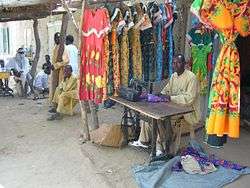Treadle

A treadle [from OE tredan, to tread] is a part of a machine which is operated by the foot to produce reciprocating or rotary motion in a machine such as a weaving loom (reciprocating) or grinder (rotary). Treadles can also be used to power water pumps (as in the treadle pump), or to turn wood lathes (as in the pole lathe). In the past, treadles have been used to power a range of machines including sewing machines, looms, wood saws, cylinder phonographs and metal lathes. Along with cranks, treadmills, and treadwheels, they allowed human and animal power of machinery in the absence of electric machinery.
Sewing machines
Many of the early sewing machines were powered by a treadle mechanism. The treadle was operated by pressing down on it with a foot, or both feet, to cause a rocking movement. This movement spins a large wheel on the treadle frame, connected by a thin leather belt to a smaller driving wheels on the sewing machine.

See also
| Look up treadle in Wiktionary, the free dictionary. |